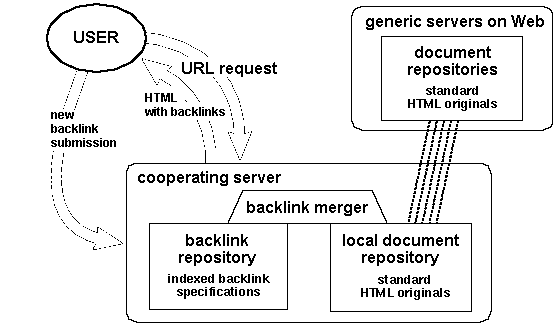Web Enhancement Project
Last updated for content 23Apr96:
The Web today is a partial hypertext system, letting readers
follow an author's pointers to past documents. To give effective
support to critical discussion on topics of public interest such
as nanotechnology, however, it must show links into a document
made by readers and later authors: it needs backlinks. Authors
cannot be expected to insert links that display criticisms or
refutations of their Web documents. With backlinks, hypertext can
become a dialog -- more enduring than speech, more interactive
than print, and better connected than anything we've had before.
It can help us deal with world-wide issues. (See the essay Hypertext Publishing and the Evolution of
Knowledge for further discussion of the need for a full
hypertext publishing system.)
Foresight's goal is to get the required features incorporated
into Web standards. To accomplish this, we will write public
domain code which implements them, run this code on our server
and as many others as will participate, and use the resulting
system for critical discussion of an issue important to the safe
and widespread Deployment of nanotechnology: computer security. A
design
for the software has been proposed.
In parallel with the technical work, Web documents will be
uploaded onto our server with some links already in place, so
that when the software is ready it will have a body of documents
to operate on. Critical discussion on computer security issues
will begin, with backlinks and filtering done by hand, prior to
completion of our software.
We are now looking for funders for the Web Enhancement Project.
We are also interested in talking with those having influence on
Web standards, both the World Wide Web Consortium (W3C) and
commercial server software providers.

Technical description
In technical terms, our goal is to implement extrinsic,
bidirectional, sub-document-level links among Web documents on
our server and (later) cooperating servers (see Definitions below). One constraint on the
project is that it produce server software compatible with common
Web browsers.
Software will be written in C or C++ to work in conjunction with
an existing http daemon (i.e. Web server software running on a
UNIX computer) to enable the following of backlinks. The software
will initially run on a single server and operate only on
documents stored on that server; later it will function with any
cooperating server.
Original documents, in standard HTML, will be stored unchanged on
the server. Our software will store backlink information for
these documents in a database. When a user invokes a document's
URL, our software will integrate the original HTML and the
backlink information, so that the user sees the backlinks in
place.
The first version will make links only to anchors that have
already been placed by the original author of the document.
Separately from the Web enhancement software, Foresight may to
add additional anchors to all documents on the server, to enable
fine-grained linking even at the initial stage.
Technical goals for later stages:
1. Support of documents on non-cooperating servers (with warning
of edits, but without sophisticated connectivity through edits).
2. Support of filtering (using Web forms to gather information on
links from the link author).
3. Fine-grained linking to the phrase or word level, if not done
previously.
4. Readers' evaluation data (gathered by Web forms from readers)
to use in filtering.
5. Better connectivity through edits (e.g. links to obsolete
wording can be appended to the end of the current document).
Definitions
- Forward links:
- Links from a document pointing onward to another
document. For example, if document A comments on document
B, a forward link in A points to B. Forward links are
already standard on the Web.
- Backward links:
- Links appearing in a document that have been inserted,
usually by someone other than the author, pointing from
that document to another. For example, if document A
comments on document B, a backward link visible in B
points to document A. Today, only forward links can be
made on the Web; no corresponding backward link appears.
Readers can see only links made by the original author.
- Bi-directional links:
- Links that work both forward and backward.
- Extrinsic links:
- Links that can be made visible from a document without
the document-author's cooperation. These are needed for
critical discussion, since we cannot expect all authors
to go out of their way to attach critical comments to
their own documents.
- Cooperating servers:
- Web servers running our (or compatible) software.
- Filtering:
- Selective display of links based on reader-selected
criteria (e.g. links to criticisms only).
- HTML:
- Hypertext markup language used to format information for
the Web.
- URL:
- Address of a document on the Web, enabling a reader to
retrieve that document.
- Anchor:
- Embedded marker enabling authors to link to a specific
part of a Web document.
Budget for initial stage
We anticipate that the first version only can be produced
in nine months on a budget of $100,000. Individual and corporate
donations of funds are solicited. Foresight Institute is a
nonprofit public foundation; donations are tax-deductible in the
U.S.
Contact: Chris Peterson, phone 415-917-1122, email foresight@foresight.org
References
1. "The Network of Knowledge," chapter 14 of Engines of Creation by K. Eric
Drexler (Anchor Press/Doubleday, 1986). The Notes give earlier
references.
See Backlinks
News for more on this topic
|